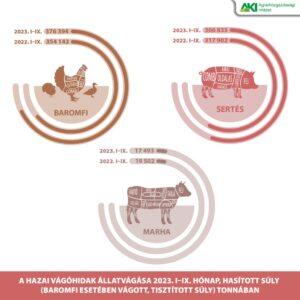Fewer pigs and cattle went to slaughterhouses
Domestic slaughterhouses slaughtered more than 376,000 tons of poultry, nearly 307,000 tons of pork, and 34,000 tons of cattle in the first three quarters of 2023 (carved weight, slaughtered for poultry, cleaned weight).

In terms of the number of pieces, 10.3 percent fewer cattle, 2.3 percent fewer pigs and 7.3 percent more poultry halves were slaughtered in the first three quarters of 2023 compared to January-September 2022. In the poultry group, turkey slaughter fell significantly (–16.8 percent), but goose and duck slaughter increased (+19.4 and +18.8 percent) in this period, compared to the low base.
63 percent of the slaughtered cattle were cows and 18 percent were bulls
The slaughter of cows decreased by 9.5 percent, that of bulls by 15.3 percent, while the slaughter of heifers increased by 5.8 percent based on the number of pieces in the first three quarters of 2023 compared to the base period. Within pig slaughter, the slaughter of sows decreased from 50.7 thousand in the first three quarters of the previous year – by more than 17 percent – to 41.8 thousand in the January-September 2023 period. The majority of poultry – 85 percent based on the number of pieces – was chicken, turkeys accounted for 2.3 percent, and ducks 10.1 percent.
AKI PÁIR
Related news
AM: Government helps farmers with a loan moratorium
🎧 Hallgasd a cikket: Lejátszás Szünet Folytatás Leállítás Nyelv: Auto…
Read more >More than 100 Hungarian farmers also demonstrated in Brussels
🎧 Hallgasd a cikket: Lejátszás Szünet Folytatás Leállítás Nyelv: Auto…
Read more >NAK: Domestic producers await customers with an ample supply of all pine species
🎧 Hallgasd a cikket: Lejátszás Szünet Folytatás Leállítás Nyelv: Auto…
Read more >Related news
Christmas shock in commerce: for the first time, we can pay with bank cards in fewer places
🎧 Hallgasd a cikket: Lejátszás Szünet Folytatás Leállítás Nyelv: Auto…
Read more >Hungarian Confectionery Manufacturers Association: trends in 2025 and prospects for 2026
🎧 Hallgasd a cikket: Lejátszás Szünet Folytatás Leállítás Nyelv: Auto…
Read more >Most grocery chains will be open until noon on December 24th
🎧 Hallgasd a cikket: Lejátszás Szünet Folytatás Leállítás Nyelv: Auto…
Read more >






